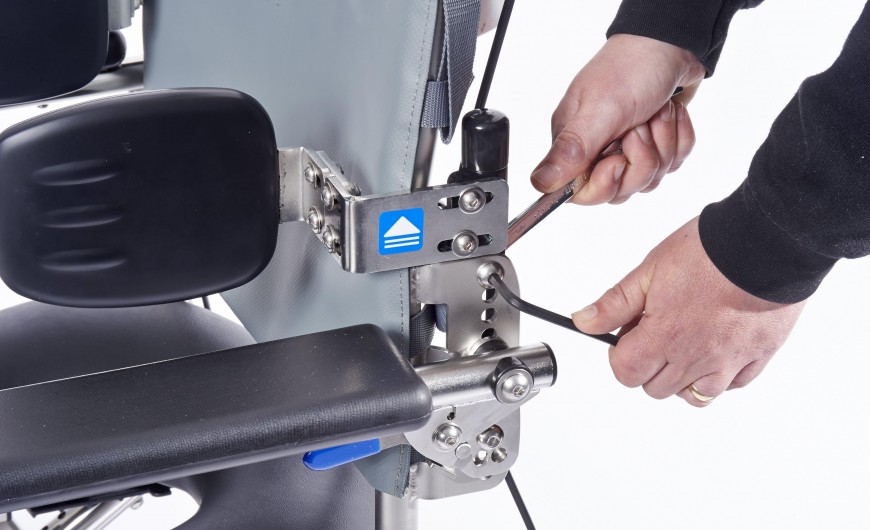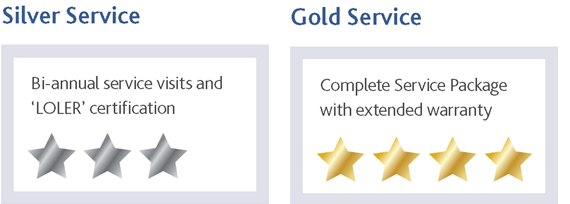When you purchase care equipment, you're making a significant investment - so it pays to look after it properly. Not only does maintained equipment deliver better results for users, but it also makes a big difference to carers, who can provide a better standard of care more easily.
The right service and maintenance contract helps equipment last longer, so you get more value from your investment. Here are 5 questions to ask to help you make the best choice for your care environment.
1. Are you getting the right level of cover?
There are 2 general types of service agreement – service plus warranty or just service – we call them Gold and Silver packages.
If you want a warranty, you must have a service contract in place for that warranty to be valid. The warranty will cover any required replacement parts.
If you just have the service element, you will have to pay for replacements. (Beware of cheap service-only contracts, because often the parts are charged at a premium.)
Be sure to investigate what is and isn’t included in the contracts you’re considering. This is a common point of confusion we see, and too often people end up paying more than necessary unintentionally.


2. How is the agreement structured?
You need a contract structure that works for you. Some care homes want an annual contract for added flexibility. Often, councils insist on 3 or 5 years, so you need an option that fits in with how you get your funding.
Look at how price increases are built in. We’ve seen companies that lock you into a 5-year contract with a clause fixing prices for 12 months. That means that for the remaining 4 years you have no control over what you pay.
Similarly, check the cancellation clause. Some contracts are written so you have to give notice to cancel; otherwise they automatically roll over and lock you in at a higher rate.
3. Does the service schedule keep you compliant with relevant regulations?
You must comply with relevant regulations on servicing and maintain the appropriate paperwork for the audit trail, as the CQC looks at these records as part of its checks.
For example, lifting equipment must comply with LOLER Regulations, which stipulate 1 full service and test per year and then a visual examination and weight test at 6 months. You need to have the lifting equipment certificated to be compliant. Timing of servicing is crucial – if it’s not done in time, the overhead hoist is effectively out of action. With the right service contract in place, you get contacted about booking this in, so you don’t have to remember anything or take proactive steps (it’s one less thing for you to worry about).
Not only is service important for safety and compliance, but it also affects staffing – it’s increasingly common for agency care workers to refuse to use lifting equipment without a LOLER sticker because their insurance doesn’t cover it. This is also crucial for users in the community, because if they have to bring in a carer, he or she needs to be able to use the hoist.
Even if there aren’t regulations in place for a particular piece of equipment (for example specialist seating, beds and shower trolleys), they always benefit from maintenance to mitigate the risk of nasty shocks.
4. What is the out-of-hours support provision?
You don’t often have to use it, but you need this peace of mind in case the need arises.
To give you an idea, we offer engineer telephone support until 10:30pm, and 95% of the time they can help with a solution that keeps you going until morning.
5. Who will be carrying out the maintenance?
It’s important to have an experienced engineer in charge of your maintenance because many issues aren’t obvious or visible to the naked eye.
For example, one of our engineers was working on a mobile hoist and identified an issue with the framework that no one had spotted – there was a hairline crack at the base of the mast, which you wouldn’t be able to see unless you were looking for it and stress testing. If this hadn’t been addressed, the hoist could have broken while in operation.
Effective maintenance reduces downtime and overall costs
If you don’t service or maintain care equipment properly, you increase the risk of downtime, which increases your whole life costs, can lead to additional outlays on rented equipment and has a major operational impact on the home.
Learn more about Wealden service and maintenance contracts here.
To discuss your requirements, contact us on 01634 813388 or email sales@wealdenrehab.com.

Featured products
Latest Blog Posts
Seasonal opening times 2025/26
2025 Holiday Season Update - Our team are here for you but we will be taking a break between the 24th December and 2nd January 2025.

New Shower Chair Innovation
Experience Wealden Rehab’s new shower chair innovation at the OT Show 2025

Responsive Care Equipment Supplier Across the UK
Supporting hospitals and care providers in unsettling times ...

NAEP Conference 2025
Meeting Occupational Therapists, Commissioners and Exploring Bariatric and Paediatric Solutions

Our Seasonal opening times 2024/25
Our team are here for you but we will be taking a break between the 24th December and 2nd January 2025.

Can a RAZ shower chair rust?
Get an in-depth look at the RAZ shower chair range and the protective features that make them built to last




